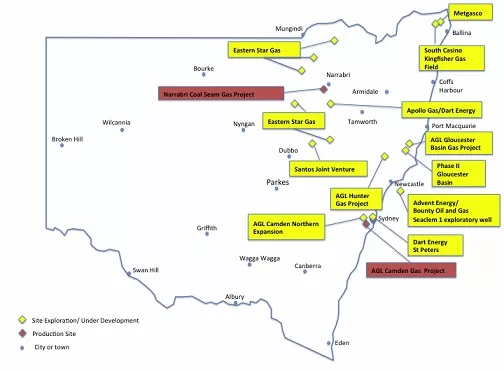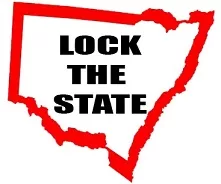The NSW Chief Scientist & Engineer, Professor Mary O’Kane, was directed by the Premier in February 2013 to conduct an independent review of the state’s coal seam gas activities.
The Terms of Reference for her review were to ask “How can the gas industry proceed?” – not “Should the gas industry proceed?” The review was concerned with overcoming obstacles to the gas industry.
On 30 July 2013, Professor O’Kane released publicly an initial report from the independent review. The initial report contains a number of recommendations to the NSW Government.
Chief Scientist & Engineer published her Final Report on 30 September 2014, including 16 recommendations to Government addressing the principles that can underpin setbacks and exclusion zones; international best practice; risk characterisation and mitigation; as well as undertake a comprehensive study of industry compliance.
Professor O’Kane’s review, the objections and associated documentation is here. 1EarthMedia’s submission to this review is here.
Chief Scientist’s Review Executive Summary
The independent review of coal seam gas (CSG) activities in NSW by the NSW Chief Scientist & Engineer commenced in late February 2013. This is the initial report of the Review, which was requested by July 2013.
Based on consultations and submissions to date, the Review makes a small number of recommendations aimed at improving the information available to the community and assisting the Government to build confidence that it has the intention and capacity to oversee a safe CSG industry.
CSG is a complex and multi-layered issue which has proven divisive chiefly because of the emotive nature of community concerns, the competing interests of the players, and a lack of publicly-available factual information.
The debate has been fuelled by unanswered concerns surrounding landholders’ legal rights, land access and use; human health; the environment, particularly relating to impacts on water; engineering and operational processes; and industry regulation and compliance. These issues remain matters of contention.
The challenges faced by government and industry are considerable and a commitment from all parties will be required to improve the existing situation and build trust with the community.
From a technical and scientific standpoint, many challenges and risks associated with CSG are not dissimilar to those encountered in other energy and resource production, and water extraction and treatment.
Some challenges are well defined and can be effectively managed through high standards of engineering and rigorous monitoring and supervision of operations.
Other challenges relating to long-term and cumulative environmental impacts are less obvious and require a commitment to significant and ongoing research, as well as a consequent evolution of engineering practice.
This initial report aims to explore the many issues of community concern – drawing on material learned through listening to stakeholders and applying an evidence-based approach to problems.
Based on the work done to date by the Review, this report recommends the NSW Government commit to adopting a vigilant, transparent and effective regulatory and monitoring system to ensure the highest standards of compliance and performance by the CSG industry.
As a first step, the Government needs to institute a strong and sophisticated policy for data collection and data handling, and establish a whole-of-environment data repository.
The Government should also implement stronger conditions around the training of CSG operators, and champion further research on the unanswered questions around the science of CSG.
There is, however, more work to do.
Based on preliminary investigations, the Review will continue the industry compliance study and the study of best practice in unconventional gas extraction technologies and regulation. It will also commission studies on risk and on exposure pathways for chemicals and contaminants.
In addition, the Review has identified areas around land owner compensation, company insurance and operator penalties which could be strengthened and, as such, has commissioned further legal work in these areas.
The issue of CSG in NSW is a very tough one with many complicated parts. A commitment to sound policy implementation based on highly developed data and further research to fill the knowledge gaps will be essential.
Terms of Reference – Review of coal seam gas activities in NSW
At the request of the NSW Government, the NSW Chief Scientist and Engineer will conduct a review of coal seam gas (CSG) related activities in NSW, with a focus on the impacts of these activities on human health and the environment.
The Chief Scientist and Engineer is to:
1. undertake a comprehensive study of industry compliance involving site visits and well inspections. The Chief Scientist’s work will be informed by compliance audits undertaken by regulatory officers, such as the Environment Protection Authority and other government agencies
2. identify and assess any gaps in the identification and management of risk arising from coal seam gas exploration, assessment and production, particularly as they relate to human health, the environment and water catchments
3. identify best practice in relation to the management of CSG or similar unconventional gas projects in close proximity to residential properties and urban areas and consider appropriate ways to manage the interface between residences and CSG activity
4. explain how the characteristics of the NSW coal seam gas industry compare with the industry nationally and internationally
5. inspect and monitor current drilling activities including water extraction, hydraulic fracturing and aquifer protection techniques
6. produce a series of information papers on specific elements of CSG operation and impact, to inform policy development and to assist with public understanding. Topics should include: operational processes NSW geology water management horizontal drilling hydraulic fracturing (fraccing) fugitive emissions health impacts wells and bores subsidence.
The NSW Chief Scientist & Engineer will provide an initial report to the Premier and the Minister for Resources and Energy on her findings and observations by July 2013.
Some material on this page © State of New South Wales through NSW Trade & Investment
Background Papers
A series of technical information papers on specific sets of issues related to the CSG industry and operations was commissioned by the Review. The papers form a key component of the Review as both an information source and assisting in developing reports and informing compliance activities.
Given concerns expressed by many in the community about the need for independent scientifically-based information, the Review placed a great deal of emphasis on engaging experts to write the background papers who were independent and had minimal or no actual, potential or perceived conflicts of interest.
A challenge, and strength, of science and research is that experts bring their own perspective to issues based on their speciality and research background, meaning that there is the possibility for disagreement on issues, or at least different perspectives and priorities. To address and also take advantage of this factor, the approach of the Review has been, where possible, to obtain multiple pieces of advice and information papers on a given topic.
Due to the relatively new nature of CSG in Australia, in some areas of examination it has proved challenging to find multiple experts without conflict. In such cases, the Review, where appropriate, will seek peer comment on individual papers from experts in cognate disciplines.
It is intended that this process will continue throughout the Review and more background papers will be commissioned as further issues and concerns come to light.
| Subject | Author | View |
|---|---|---|
| Community Concerns | Dr Melanie Taylor, Ms Natalie Sandy & Professor Beverly Raphael Disaster Response and Resilience Research Group School of Medicine University of Western Sydney | View |
| Data | Intersect Australia | View |
| Groundwater Resources | DJ Anderson, PF Rahman, EK Davey, BM Miller and WC Glamore Water Reserach Laboratory, University of New South Wales | View |
| Horizontal Drilling | Professor John Carter Advanced Geomechanics | View |
| Methane origins and behaviour | Dr Linda Stalker Science Director – National Geosequestration Laboratory, CSIRO | View |
| Modelling the Airborne Dispersion of Pollutants from Coal Seam Gas Extraction | Peter J. Rayner and Steven Utembe | View |
| Multi basin usage/ cumulative impacts | Associate Professor Tim Rawling & Professor Mike Sandiford Melbourne Energy Institute University of Melbourne | View |
| NSW Geology | Professor Colin Ward & Associate Professor Bryce Kelly School of Biological, Earth and Environmental Sciences University of New South Wales | View |
| NSW Geology | Dr Craig O’Neill & Dr Cara Danis Department of Earth and Planetary Science Macquarie University | View |
| Produced Water | Associate Professor Damian Gore & Dr Peter Davies Department of Environment & Geography, Faculty of Science Macquarie University | View |
| Produced Water and Solids | Stuart Khan & Geena Kordek School of Civil Environmental Engineering, University of New South Wales. | |
| Seismicity and induced earthquakes | Gary Gibson & Professor Mike Sandiford Melbourne Energy Institute University of Melbourne | View |
| Seismicity and induced earthquakes | Dr Barry Drummond | View |
| Subsidence Causes | Dr Jubert A. Pineda & Professor Daichao Sheng ARC Centre of Excellence for Geotechnical Science and Engineering The University of Newcastle Australia | View |
| Subsidence Monitoring | Dr Simon McClusky & Dr Paul Tregoning Research School of Earth Sciences The Australian National University | View |
| Subsidence Monitoring | Cooperative Research Centre for Spatial Information | View |
| Technologies and Potential Impacts | Professor Peter J Cook CBE, FTSE | View |
Disclaimer: Recognising that information in these documents is provided by third parties, the State of New South Wales, the author and the publisher take no responsibility for the accuracy, currency, reliability and correctness of any information included in the document provided by third parties. These third party comments do not necessarily reflect the views of the NSW Chief Scientist and Engineer and her Office.
Map of CSG Potential and Restricted Areas

This map shows CSG potential and restricted areas in NSW.



